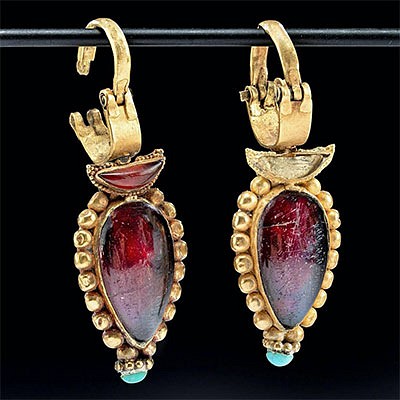Moche Wood, Shell, & Nacre Ear Spool w/ Birds
Lot 121
About Seller
Artemis Fine Arts
686 S Taylor Ave, Ste 106
Louisville, CO 80027
United States
Selling antiquities, ancient and ethnographic art online since 1993, Artemis Gallery specializes in Classical Antiquities (Egyptian, Greek, Roman, Near Eastern), Asian, Pre-Columbian, African / Tribal / Oceanographic art. Our extensive inventory includes pottery, stone, metal, wood, glass and textil...Read more
Estimate:
$2,600 - $3,900
Absentee vs Live bid
Two ways to bid:
- Leave a max absentee bid and the platform will bid on your behalf up to your maximum bid during the live auction.
- Bid live during the auction and your bids will be submitted real-time to the auctioneer.
Bid Increments
| Price | Bid Increment |
|---|---|
| $0 | $25 |
| $300 | $50 |
| $1,000 | $100 |
| $2,000 | $250 |
| $5,000 | $500 |
| $10,000 | $1,000 |
| $20,000 | $2,500 |
| $50,000 | $5,000 |
| $100,000 | $10,000 |
| $200,000 | $20,000 |
About Auction
By Artemis Fine Arts
Nov 11, 2021
Set Reminder
2021-11-11 12:00:00
2021-11-11 12:00:00
America/New_York
Bidsquare
Bidsquare : It's a Small World | Diminutive Artifacts
https://www.bidsquare.com/auctions/artemis-gallery/its-a-small-world-diminutive-artifacts-7836
Join us for a very special auction featuring art & artifacts from East to West, North to South, and everywhere in between - with one small thing in common - size! Everything in this auction is approximately 6 inches or less - perfect for that last bit of shelf space in your curio cabinet! Artemis Fine Arts info@artemisgallery.com
Join us for a very special auction featuring art & artifacts from East to West, North to South, and everywhere in between - with one small thing in common - size! Everything in this auction is approximately 6 inches or less - perfect for that last bit of shelf space in your curio cabinet! Artemis Fine Arts info@artemisgallery.com
- Lot Description
Pre-Columbian, North Coast Peru, Moche, ca. 100 to 500 CE. A lovely and large shell and wood earspool with symbolic avian iconography. The earspool is comprised of a disc-shaped piece of wood inlaid with delicate carved nacre (mother of pearl) and Spondylus shells. The face features an inlaid design of ten birds in profile with one double headed bird at the center. The birds are made of nacre with turquoise stone eyes are inlaid within the face and surrounded by with shards of pink spondylus shell. All along the circumference of the ear spools are rectangular pieces of spondylus and nacre. The verso contains a circular panel of nacre with five piercings in the center. Earspools such as this were commissioned by a powerful lord who wanted to display his prestige and animal attributes. These ear spools are replete with powerful symbolic value, for in the Pre-Columbian world, the birds as sky animals were regarded as messengers between humankind and the deities of the celestial realm, and perhaps these nacre birds whispered wisdom in the lord's ears. Size: 2" Diameter x 0.375" W x 3.5" H (5.1 cm x 1 cm x 8.9 cm)
To the ancients of the Pre-Columbian world, birds, especially hummingbirds (picaflores in Spanish) were associated with the sun. Appreciated for shiny, iridescent feathering and aerial acrobatics, the hummingbird made for the ideal solar metaphor. Since these birds are known to hover, seemingly motionless, and fly up, down and even backwards, the ancients likened their motions to the sun's hovering in the sky at the solstices when it is also known to reverse its celestial direction. In addition, hummingbirds can assume a torpid state when it is cold at night or during brief periods in the winter. However, they come back to life in the spring warmth. This unique ability to "die" and "resurrect" signified rebirth to the ancients, precisely at a time when planting and, in this sense, "renewed life" occurred.
Spondylus shells have been revered by Andean peoples since the Pre-Columbian era. In addition to being featured in their artwork and used as currency, Spondylus pieces served as sacred offerings to Pachamama, the earth/time mother, a version of Mother Nature. The Spondylus shell carries numerous symbolic meanings. A symbol of fertility and elite social status, it was also believed to be an omen of rain, warning the indigenous of El Nino. In fact, the Spondylus shell only appears when the water becomes warmer during December - the time of the El Nino current - immediately before the rainy season.
Provenance: private Hawaii, USA collection; ex-private Hans Juergen Westermann collection, Germany, collected from 1950 to 1960s
All items legal to buy/sell under U.S. Statute covering cultural patrimony Code 2600, CHAPTER 14, and are guaranteed to be as described or your money back.
A Certificate of Authenticity will accompany all winning bids.
PLEASE NOTE: Due to recent increases of shipments being seized by Australian & German customs (even for items with pre-UNESCO provenance), we will no longer ship most antiquities and ancient Chinese art to Australia & Germany. For categories of items that are acceptable to ship to Australia or Germany, please contact us directly or work with your local customs brokerage firm.
Display stands not described as included/custom in the item description are for photography purposes only and will not be included with the item upon shipping.
#164490Old inventory label on verso. Losses to shells on peripheries. Stable fissures on two birds. Losses of eyes. Chip to shell on verso. Great preservation of birds and nice iridescence.Condition
- Shipping Info
-
All shipping is handled in-house for your convenience. Your invoice from Artemis Gallery will include shipping calculation instructions. If in doubt, please inquire BEFORE bidding for estimated shipping costs for individual items.
-
- Buyer's Premium



 EUR
EUR CAD
CAD AUD
AUD GBP
GBP MXN
MXN HKD
HKD CNY
CNY MYR
MYR SEK
SEK SGD
SGD CHF
CHF THB
THB













